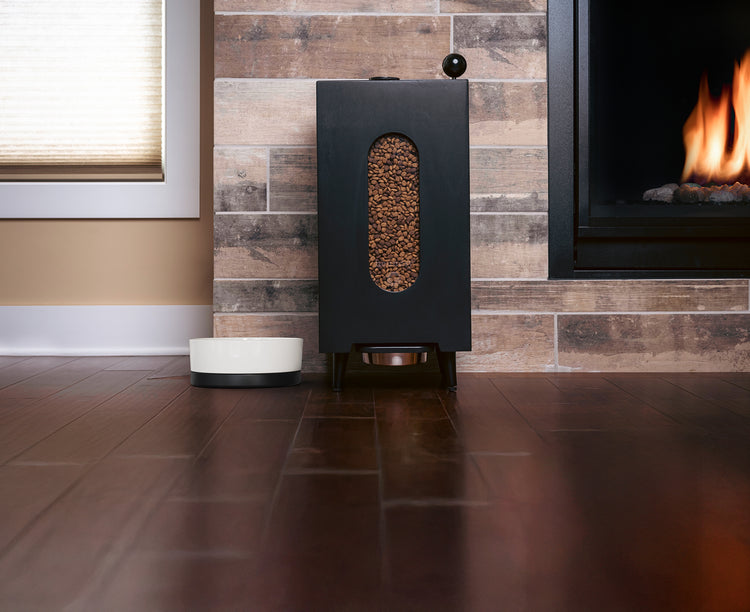Can Dry Dog Food Be Left in a Hot Car? Understanding the Risks and Best Practices
- Houndsy
Table of Contents
- Introduction
- The Impact of Temperature on Dry Dog Food
- The Risks of Leaving Dog Food in a Hot Car
- Best Practices for Storing Dry Dog Food
- Understanding Dog Food Labels
- The Role of Feeding Rituals in Pet Care
- Conclusion
- FAQ
Introduction
Imagine it’s a warm summer day, and you’ve just returned from a fun outing with your furry friend. You pop open the car door, and the heat hits you like a brick wall. The last thing on your mind is the bag of dry dog food you left in the back seat. But now, as you glance at it, you can’t help but wonder: Can dry dog food be left in a hot car?
As pet owners, we strive to provide the best for our dogs, including ensuring their food remains fresh and safe. However, many of us may not realize the potential dangers of storing dry dog food in extreme temperatures. In this blog post, we will explore the implications of leaving dry dog food in a hot car, how heat affects its quality, and best practices to ensure your pup's meals are both safe and nutritious.
By the end of this article, you will have a comprehensive understanding of the risks associated with high temperatures and dog food storage, along with practical tips to avoid any mishaps. So, let’s dive in and reflect on our own pet feeding routines while ensuring our beloved companions receive only the best nourishment.
The Impact of Temperature on Dry Dog Food
How Heat Affects Dry Dog Food
Dry dog food is formulated to withstand certain environmental conditions, but extreme temperatures can significantly compromise its quality. When exposed to heat, several changes can occur:
- Rancidity: The oils used in many dry dog foods can go rancid when subjected to high temperatures. Rancid oils not only alter the taste but can also cause gastrointestinal issues for your dog.
- Nutritional Degradation: Vitamins and minerals can degrade under heat, leading to a loss of essential nutrients your dog needs for optimal health.
- Moisture and Mold: If the dry food becomes moist due to high humidity or condensation, it can create an ideal environment for mold growth. Moldy food can be toxic to dogs and lead to severe health problems.
Safe Temperature Ranges for Dog Food
The ideal storage temperature for dry dog food generally falls between 50°F and 70°F. Above 70°F, the risks of spoilage and degradation begin to increase. Once temperatures reach the 80s or higher, the food may start deteriorating rapidly. Therefore, it’s crucial to consider where you store your dog’s food, particularly during hot weather.
The Risks of Leaving Dog Food in a Hot Car
Short-Term Exposure
Leaving dry dog food in a hot car for a few hours may not seem harmful at first, but even short-term exposure to extreme heat can have consequences. For instance, if you park your car in direct sunlight on a day when the temperature is over 90°F, the interior can heat up to a sweltering 130°F or more in a matter of minutes.
This elevated temperature can lead to rancidity and nutrient loss, even if the food is still technically safe for consumption. If you’ve ever opened a bag of dry dog food that smells off or rancid, you know it’s best to toss it out.
Long-Term Exposure
Prolonged exposure to high heat can be even more detrimental. If a bag of dry dog food is left in a hot car for days, the likelihood of spoilage increases significantly. Not only can the oils become rancid, but the food may also attract pests or develop mold, making it unsafe for your dog.
The Effect of Humidity
While heat is harmful, humidity compounds the problem. Combining heat with moisture creates the perfect environment for mold and bacteria to thrive. If you live in a humid climate, it’s especially important to avoid leaving dry dog food in a hot car, as the humidity can exacerbate the risks associated with temperature.
Best Practices for Storing Dry Dog Food
Ideal Storage Locations
To maintain the quality of your dog’s dry food, consider the following storage tips:
- Cool, Dry Place: Always store dry dog food in a cool, dry area, away from direct sunlight. A pantry or a dedicated pet food container in a climate-controlled space is ideal.
- Sealed Containers: Use airtight containers to store dry dog food. This not only helps keep moisture out but also prevents the food from absorbing odors from other items in your home.
Traveling with Dog Food
When traveling with your dog, it’s essential to plan ahead to avoid leaving food in a hot car:
- Bring a Cooler: If you're going to be away from home for an extended period, consider using a cooler to transport your dog’s food. This can help regulate the temperature and keep the food fresher.
- Plan Your Stops: If you need to stop somewhere, try to do so when it’s cooler outside, or take the food with you instead of leaving it in the car.
Understanding Dog Food Labels
Reading Labels for Quality Assurance
Understanding the ingredients and storage instructions on your dog food packaging is crucial. Look for the following:
- Expiration Dates: Always check the expiration date before purchasing or feeding your dog food. Even if the food looks and smells fine, consuming expired food can pose health risks.
- Storage Instructions: Many dog food manufacturers provide specific storage instructions designed to help maintain freshness. Follow these guidelines closely.
Choosing High-Quality Dog Food
Investing in high-quality dog food can also make a difference in how well it withstands temperature changes. Look for brands that prioritize quality ingredients and have robust packaging. Products like the Houndsy Kibble Dispenser not only provide a stylish way to store food but also keep it fresh and safe from pests.
The Role of Feeding Rituals in Pet Care
Establishing Consistent Feeding Times
Having a consistent feeding routine can help you monitor your dog’s food intake and ensure it’s being stored correctly. By setting specific times for feeding, you can avoid situations where food gets left in a hot car. Consider the following:
- Use a Timer: Set reminders on your phone or an alarm clock to signal feeding times.
- Portion Control: Use the Houndsy Kibble Dispenser to dispense the right amount of food each time without the need for measuring cups. This not only simplifies feeding but also helps reduce waste.
Enhancing the Feeding Experience
Our feeding rituals are as much about our experience as they are about our pets'. Using stylish and functional feeders, like the Houndsy Kibble Dispenser, can elevate the overall experience for both you and your dog, making meals something to look forward to.
Conclusion
In summary, leaving dry dog food in a hot car can pose significant risks to your dog’s health. The combination of heat and humidity can lead to rancidity, nutrient loss, and even spoilage. By understanding the importance of proper food storage and implementing best practices, you can ensure your dog receives safe and nutritious meals.
As responsible pet owners, we must continually reflect on our pet feeding routines and make adjustments as necessary. Consider upgrading to a stylish and functional feeding solution like the Houndsy Kibble Dispenser to enhance your dog’s feeding experience while ensuring their food stays fresh and safe.
Don’t forget to check out our Accessories collection for matching items that will complement your feeding setup and fit seamlessly into your home decor.
FAQ
Can I feed my dog dry food that has been left in a hot car for a short period?
While it may not be immediately harmful, it’s best to avoid feeding your dog food that has been left in a hot car. Even short exposure can lead to rancidity and nutrient loss.
How can I tell if my dog’s dry food has gone bad?
Signs of spoiled dog food include an off or rancid smell, discoloration, or the presence of mold. If you notice any of these signs, discard the food immediately.
Is it safe to store dry dog food in the garage?
Storing dry dog food in the garage is not recommended, especially in warmer climates. Garages can experience fluctuating temperatures, which can negatively impact the food.
What should I do if my dog eats spoiled food?
If you suspect your dog has eaten spoiled food, monitor them for symptoms such as vomiting, diarrhea, or lethargy. If symptoms appear, contact your veterinarian for advice.
How can I keep my dog's food fresh while traveling?
Use a cooler to transport your dog's food when traveling and avoid leaving it in a hot car. Additionally, consider portioning out meals ahead of time to minimize the risk of spoilage.
For more information on how to enhance your pet’s feeding experience, explore the Houndsy Kibble Dispenser and our Accessories collection today!












